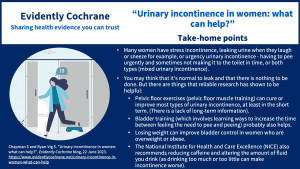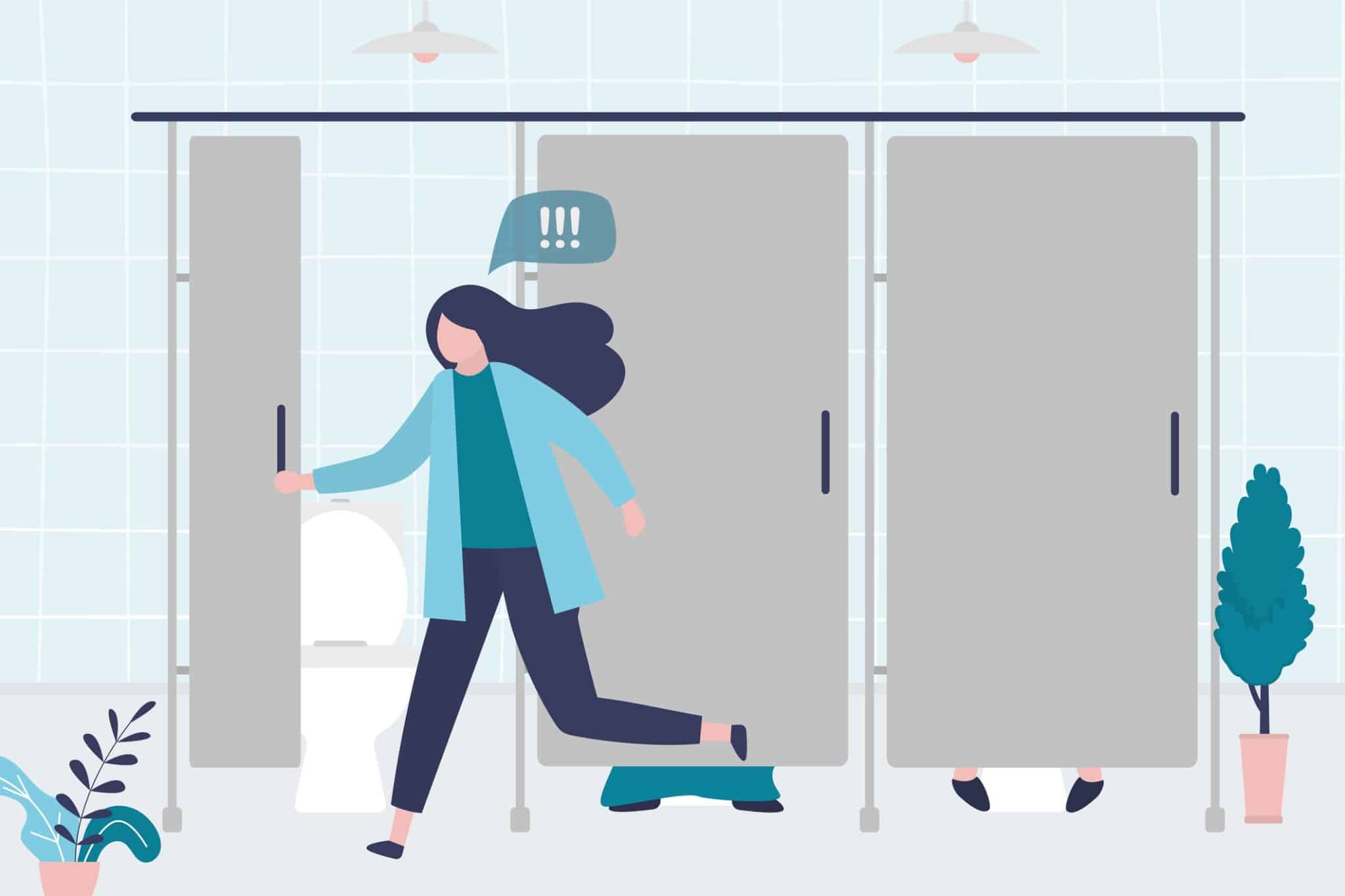Many women have urinary incontinence but there are things that can help. In this short blog, Cochrane UK’s Sarah Chapman and Selena Ryan-Vig take a look at some options and the evidence for them. There are also links to trustworthy sources of information and help.
Take-home points

It’s very common for women to leak urine. Stress incontinence, where urine leaks out when you sneeze or exercise, for example, is the most common type. Having to pee often and sometimes not making it to the toilet in time is called urgency (or urge) incontinence. Some women have both types (mixed urinary incontinence). This blog is about these types of incontinence.
With pads and other incontinence products displayed next to period products in our shops and advertised widely on our screens, you might think that it’s normal to leak and that there is nothing to be done beyond catching the pee. Not so. There are things that reliable research has shown to be helpful.
Pelvic floor muscle training
Good news. There is reliable evidence that pelvic floor muscle training (PFMT) – also called pelvic floor exercises and sometimes ‘Kegels’ – is effective for curing or improving most types of urinary incontinence, at least in the short term. (There is a lack of long-term information).
The pelvic floor muscles run between your tailbone (coccyx) and pubic bone, and support the bladder, bowel, vagina and womb. They help control the flow of urine as you pee.
If you seek help from a GP for urinary incontinence they may refer you to a specialist (often a physiotherapist) to start a programme of PFMT which you can do at home. There is also information from the NHS about pelvic floor exercises here.
There is evidence that pelvic floor exercises probably work better if:
- they are more intense
- you use strategies to help you carry on doing your exercises
- you have support from a health professional, such as a nurse or physiotherapist with specialist training
The National Institute for Health and Care Excellence (NICE) recommends that women with stress or mixed urinary incontinence should be offered a trialClinical trials are research studies involving people who use healthcare services. They often compare a new or different treatment with the best treatment currently available. This is to test whether the new or different treatment is safe, effective and any better than what is currently used. No matter how promising a new treatment may appear during tests in a laboratory, it must go through clinical trials before its benefits and risks can really be known. of supervised pelvic floor muscle training of at least three months, and that at least eight contractions (muscle squeezes) should be done three times a day.
Bladder training
This involves learning ways to increase the time between feeling the need to pee and peeing. A health professional, such as a GP or nurse, delivers the training. NICE recommends offering bladder training lasting at least six weeks to women with urgency or mixed urinary incontinence (it doesn’t mention stress incontinence in relation to bladder training).
Lifestyle changes
NICE recommends reducing caffeine intake to see if this helps and altering the amount of fluid you drink, as drinking too much or too little can make incontinence worse. There is reliable evidence that losing weight can improve bladder control in women who are overweight or obese.
Where can I find more information and support?
- 10 ways to stop leaks on the NHS website includes self-help tips and lifestyle advice to try and relieve symptoms.
- NHS continence services: These are centres staffed by specialist nurses and physiotherapists. They may be able to help you without a referral from your GP. A quick online search for ‘NHS continence service’ in your area should help you find your closest one.
- Incontinence products: As we said at the start, leaking is not normal. Incontinence products shouldn’t be seen as an answer but as coping strategies to be used while needed alongside treatmentSomething done with the aim of improving health or relieving suffering. For example, medicines, surgery, psychological and physical therapies, diet and exercise changes., or when all treatment options have been exhausted. You can get help and advice on incontinence products on this NHS page and from a continence specialist.
The evidence in this blog comes from: Todhunter-Brown A, Hazelton C, Campbell P, Elders A, Hagen S, McClurg D. Conservative interventions for treating urinary incontinence in women: an Overview of Cochrane systematic reviews. Cochrane Database of Systematic ReviewsIn systematic reviews we search for and summarize studies that answer a specific research question (e.g. is paracetamol effective and safe for treating back pain?). The studies are identified, assessed, and summarized by using a systematic and predefined approach. They inform recommendations for healthcare and research. 2022, Issue 9. Art. No.: CD012337. DOI: 10.1002/14651858.CD012337.pub2.
You can join in the conversation on Twitter with @CochraneUK or leave a comment on the blog.
Please note, we cannot give specific medical advice and do not publish comments that link to individual pages requesting donations or to commercial sites, or appear to endorse commercial products. We welcome diverse views and encourage discussion but we ask that comments are respectful and reserve the right to not publish any we consider offensive. Cochrane UK does not fact-check – or endorse – readers’ comments, including any treatments mentioned.


